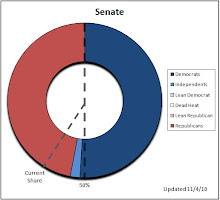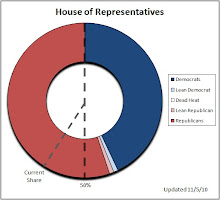Senate
Democrats - 53 (-6)
Republicans - 47 (+6)
** - Washington could still turn, but current totals suggest a Democratic victory there and there is little reason to believe that will change.
House of Representatives
Democrats - 193 (-64)
Republicans - 242 (+64)
** - Like in Washington, there are several House races still tabulating votes across the country, so this number could fluctuate one or two seats in either direction but this is more or less the final tally.
First of all, I would like to say that my projections were nearly spot on in the House. Senate projections were not as good. It appears that polling systematically overvalued Republican candidates in a few key Senate races. Nate Silver presents some interesting ideas for why this was the case on the FiveThirtyEight blog over at the New York Times.
Still, this was a monumental election for Republicans. A pick up of 6 seats in the Senate, though somewhat less than what some forecasters foresaw, represents a doubling of typical mid-term pickups for the out-party. Additionally, the 2010 electoral map was very unfavorable to monumental shifts, considering roughly half of the seats (18 out of 37) up for grabs were already in Republican hands. Compare that to 2012 elections where 21 of the 33 seats up for election are Democrats, and 2 more are Independents who currently caucus with the Democrats. Imagine if that had been the case this year! We would have seen a shift unlike any in the modern era.
Victory in the House cannot be overstated, though. As predicted, Republicans picked up more seats than any party in any single election since 1948 when Democrats picked up 75. For a moment, let's look at where those pick ups came from. The first map shades states based on the absolute number of seats gained for Republicans or Democrats (Delaware and Hawaii both actually saw a net pick-up for Democrats). The second map shades states based on percentage of the delegation from each state that switched parties.


As you can see, pick-ups came from across many regions of the country. The biggest gaps are in the Midwest which is most likely because those delegations were already Republican. New England is also blank, with the important exception of New Hampshire where the Congressional delegation completely switched over to Republican hands. This represents the first Republican foothold in New England in several years. New Hampshire and Connecticut had been Republican until 2006 when Democrats took over the Congressional delegations of both states. 2008 saw the complete extermination of the New England House Republican. Many believed this was the end of the Republican Party in New England. New Hampshire Republicans have proven them wrong.
Overlooked in a lot of this is the unbelievable victories by Republicans in state governments across the country on Tuesday. According to NCSL, Republicans have now reached their greatest strength in State Legislatures across the country since 1928!
The following map shows party control of state legislatures prior to the election:

Here is the party control of state legislatures after the election:

Republicans also did well in Governor's races.
Here is party control of the governor's office prior to the election:

Here is party control of the governor's office after the election:

Why does this matter? Aside from a significant amount of policy that effects everybody's daily lives taking place at the state level, including the implementation of the new health care law, these elections were especially important this year for one reason: REDISTRICTING!
As you most likely are aware, the government has been busy carrying out the census this year. That means that, before 2012, we are going to have a new electoral map. That map is shaped by state governments. There is considerable research that has shown that redistricting can lead to significant seat swings, some even suggests that Southern redistricting was one of the key components to the 1994 Republican Revolution.
Republicans now have more control over those state governments than they have since 1928! That is sure to impact future elections in a huge way.
And, finally, I would like to discuss one of the most popular talking points of pundits on election night, that the Tea Party had a bad night. They point to the failures of Joe Miller, Christine O'Donnell, and Sharron Angle in taking down their Democratic opponents after taking down the Republican establishment candidates. They do not consider, however, the success of Marco Rubio and Pat Toomey. Even more, they treat these races as if they are in a vacuum. The historic nature of this election, with historic victories that you have to go deep into the record books to find comparable results, cannot simply be attributed to the economy. This election was, at least in party, a direct result of Tea Party enthusiasm for this new Republican Party. These candidates provided hope for a giant group of people that had become disillusioned with the Republican party and Washington politics.
Whether or not a few particular candidates won, the Tea Party was not even close to a failure, it was the primary catalyst behind Republican gains on Tuesday! Anger over government mandates, soaring national debts, and an unwillingness to jump start the economy with much needed tax cuts were channeled into Republican support by the Tea Party movement.
Now, we move on. Elections are over. Governing commences. My blog will shift focus to party strategies moving forward. I will, from time to time, cast an eye towards 2012, but will for the most part stay in the here and now for a while.










